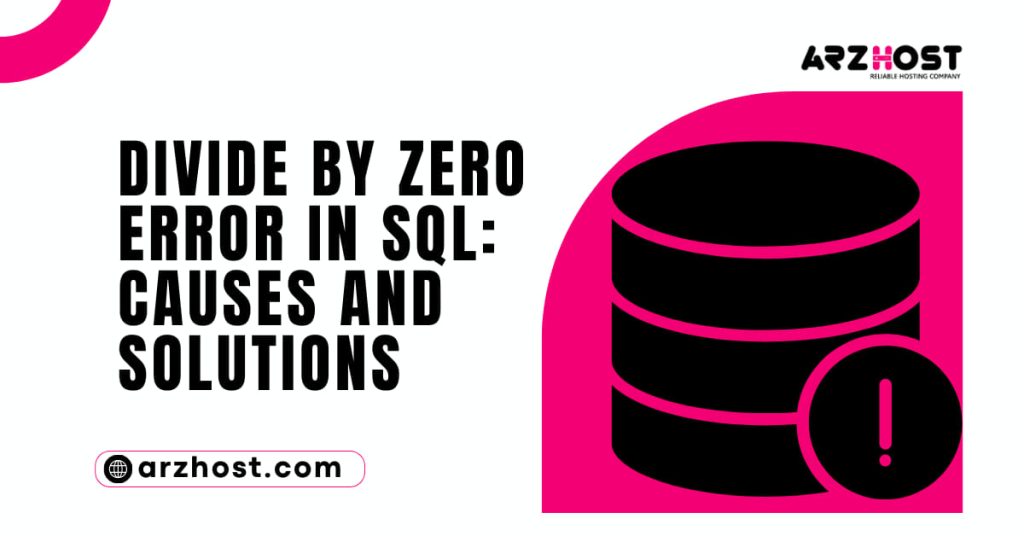Lately, one of our customers went over this screw-up as it is unbelievable to hope to parcel a number by nothing. It prompts preservation. We perform data assessments in SQL Server for various considerations. As a part of your Server Management Services, we assist our customers with a couple of SQL requests “Divide by Zero Error in SQL method” around here at ARZHOST.COM, let us see how to fix this mix-up.
Cause for the error SQL Server parcel by zero slip-ups experienced
Permit us to see what could cause the fault SQL Server parcel by zero error experienced. In any case, “Divide by Zero Error in SQL method” If the product2 sum leaves stock and that suggests we don’t have any sum for product2.
Declare @Product1 INT;Declare @Product2 INT;SET @Product1 = 50;SET @Product2 = 0;SELECT @Product1/@Product2 Product Ratio;
“Divide by Zero Error Encountered SQL”, We get SQL segment by zero mix-up messages (message id 8134, level 16):
Msg 8134, Level 16, State 1, Line 13Division by zero screw-ups experienced.
How to address the error SQL Server parcel by zero slip-ups experienced?
Constantly, it is a best practice to form code to not give parcel by zero message. “Divide by Zero Error in SQL method”, should have an instrument to oversee such conditions.
Pushing forward, let us see effective systems followed by our Hosting Expert Planners use to handle this mistake.
Methodology 1: SQL NULLIF Function
From the start, “Divide by Zero Error Encountered SQL” we use NULLIF ability to avoid segment by zero error message.
The syntax of NULLIF work:
NULLIF (expression1, expression2)It recognizes two conflicts.- Above all else, if both the conflicts are the same, it returns an invalid value
For example, expect that the value of the two disputes is 10.
SELECT NULLIF (10, 10) result;
For the present circumstance, “Divide by Zero Error in SQL method”, the yield will be invalid.
- Likewise, if both the conflicts are not the same, it returns the value of the essential dispute.
“Divide by Zero Error Encountered SQL”, both struggle regards to contrast. It returns the yield as the worth of the first dispute 10.
SELECT NULLIF (10, 5) result;
We can change our basic inquiry using the SQL NULLIF expression. We place the going with reasoning using NULLIF work for shedding SQL parcel by zero screw up:
- Use NULLIF work in the denominator with second dispute regard zero
- If the value of the primary dispute is in manner zero, this limit returns an invalid value. In SQL Server, if we segment a number with invalid, the yield is invalid as well.
- On the off chance that the value of the essential dispute isn’t zero, it returns the principle conflict value and division occurs as standard characteristics.
Declare @Product1 INT;Declare @Product2 INT;SET @Product1 = 50;SET @Product2 = 0;SELECT @Product1/NULLIF(@Product2,0) Product Ratio;
Execute this modified inquiry. “Divide by Zero Error in SQL method”, We will get the yield as NULL the denominator contains zero.
If we needn’t bother with the invalid worth in the yield, we can use SQL ISNULL ability to avoid invalid characteristics in the yield and show an unmistakable value. This limit replaces the invalid worth in expression1 and returns expression2 regard as yield.
Methodology 2: Using CASE explanation to avoid section by zero error
You can use a CASE declaration in SQL to return regards conditional upon unequivocal conditions. “share by Divide by Zero Error in SQL method” The Case clarification checks for the value of @Product2 limit:
- If the @Product2 regard is zero, it brings an invalid back.
- If the above condition isn’t satisfied, it does the calculating movement (@Product1/@Product2) and returns the yield.
Report @Product1 INT;Report @Product2 INT;SET @Product1 = 50;SET @Product2 = 0;SELECT CASERight when @Product2 = 0Then, NULLELSE @Product1/@Product2END AS Product Ratio;
“Divide by Zero Error Encountered SQL method”, We will get yield as NULL.
Methodology 3: SET ARITHABORT OFF
“Divide by Zero Error in SQL method”, SQL Server has a default worth of SET ARITHABORT is ON. We get SQL segment by zero error in the yield using the default lead. The T-SQL historical design for controlling the ARITHABORT decision is shown underneath:
SET ARITHABORT {ON | OFF}
- Using ARITHABORT ON, the request will end with a parcel with zero message. It is the default lead.
- SET ARITHABORT ON Default
- SET ANSI_WARNINGS ON
Articulate @Product1 INT;Articulate @Product2 INT;SET @Product1 = 50;SET @Product2 = 0;SELECT @Product1/@Product2 Product Ratio;
“Divide by Zero Error Encountered SQL method”, We get the SQL parcel by zero mix-up messages.
- Using ARITHABORT OFF, the bunch will end and returns an invalid value. We need to use ARITHABORT in blend in with SET ANSI_WARNINGS OFF to avoid the error message:
SET ARITHABORT OFFSET ANSI_WARNINGS OFFDeclare @Product1 INT;Declare @Product2 INT;SET @Product1 = 50;SET @Product2 = 0;SELECT @Product1/@Product2 Product Ratio;
We will get the yield as NULL.
“Divide by Zero Error Encountered SQL method”, you can use the going with a question to truly investigate the current definition for the ARITHABORT limit:
Articulate @ARITHABORT VARCHAR (3) = OFF;In the event that ((64 and @@OPTIONS) = 64) SET @ARITHABORT = ON;SELECT @ARITHABORT AS ARITHABORT;
The default ARITHABORT setting for SQL Server Management Studio (SSMS) is ON. We can see it using SSMS Tools properties. Investigate to Tools – > Options – > Advanced.
We should not change the value of ARITHABORT except for required. “Share by Zero Error Encountered SQL method” might make performance issues, as well. It is more brilliant to use various methods for avoiding SQL segment by zero error.
Conclusion
Along these lines, “Share by Divide by Zero Error in SQL method”, we saw how our Hosting Expert Planners settle fault SQL Server segment by zero error experienced.
People Frequently Ask
Learn More about SQL Error———-
Question # 1: What is divided by zero error SQL?
Answer: Msg 8134, Level 16, State 1, Line 1 Divide by zero error encountered. This error is caused by performing a division operation the denominator or the divisor is 0. This error is not encountered the denominator or divisor is NULL this will result in a NULL value.
Question # 2: What will you do to handle divide by zero in a SQL query?
Answer: If you’d like to handle division by zero you can use the NULLIF function. NULLIF takes two arguments: the expression of interest and the value you want to override. If the first argument is equal to the second, then NULLIF returns NULL; it returns the first argument.
Question # 3: Why can’t we divide by zero?
Answer: These notes discuss why we cannot divide by 0. The short answer is that 0 has no multiplicative inverse, and any attempt to define a real number as the multiplicative inverse of 0 would result in the contradiction 0 = 1. These notes may be useful for anyone with questions about dividing by 0.
Question # 4: Is 0 divided by 0 defined?
Answer: So zero divided by zero is undefined. Just say that it equals. We can say that zero over 1 equals zero. We can say that zero over zero equals that we’re a lot of times faced with, is 1 divided by zero, which is still undefined.
Question # 5: What happens if you divide by zero in Java?
Answer: Dividing by zero is an operation that has no meaning in ordinary arithmetic and is undefined. According to the Java specification of the division operation, we can identify two different cases of division by zero: integers and floating-point numbers.










